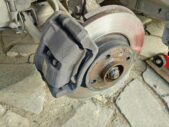
High-temperature grease for brake caliper guides
Content
Not a single disc brake system of a car is complete without a caliper. This is almost the main figure in this system. At the slightest deviations in work, and even more so with obvious breakdowns, they must be immediately eliminated. The braking system is the basis for the safety of the motorist and is no joke with it. In order to prevent any damage, facilitate the work of the caliper and not resort to, for example, repairing the rear caliper, it is necessary to lubricate it regularly using high-temperature grease for the guide calipers. How to do it correctly, what types of lubricants are there, and what type is most suitable for your car? Let's figure it out now.
Standards for modern slideway lubricants
The shelves in the store are full of a great variety of different types of lubricants. And, according to the label, they are all super versatile, even apply to the wound. But each car is unique and any oil will not work for it. Therefore, when planning a shopping trip, it is important to determine what type of product is right for you in all respects. To do this, pay attention to some details.
First, the lubricant must be thermally stable. She should not be afraid of the temperature even at +180 C. Probably, those who are interested in this topic have already encountered the peculiarities of the car, which means they know how quickly and strongly the brake system heats up during operation. For this reason, thermal stability is so important when choosing a lubricant.

high temperature grease for slideways
Secondly, we will make sure that the grease does not give in to dripping. For those who do not know, this is the process of melting and flowing out of lubricant under the influence of high temperatures. This indicator is no less important than the first.
Thirdly, it should be taken into account that during the operation of the caliper, water or chemicals from the environment can get into it. The lubricant must be ready for such footsteps of fate, which means it must not dissolve in water and behave inert towards any elements of the periodic table.
Classification of lubricants
There are 3 groups of lubricants in total. Each has a number of its own characteristics. Let's see what features lie in each of them.
Group I
This group is represented by high temperature slideway lubricants and extreme pressure pastes. They are typically used to lubricate staples, anti-squeak plates or metal surfaces on the back of the pads. But this group is special. She is the only one divided into several more divisions, which are due to various fillers. Let's consider this classification as well.
Filler classification
- grease filled with molybdenum disulfide;
- complex lubricant, to which a mixture of powder of aluminum, graphite and copper is added;
- grease that uses non-metallic fillers;
- copper or graphite acts as a filler.
Group II
The second category includes those lubricants with which other parts of the calipers are processed. This refers to the edges of the pistons, bushings, oil seals, pins, bolts. It is impossible not to notice that it is strictly forbidden to replace this grease with any other.
Group III
The most versatile group remained for a snack. It is suitable for the lubrication of absolutely all parts, as well as elements made of elastomers and plastics. Apparently this is the reason for such popularity among modern motorists. Although the price of it bites painfully. But there is something to pay for here.
Based on the information provided above, we can come to a conclusion. That all lubricants are different. Each type has its own properties and distinctive features. It is these features that serve as indicators for choosing the required type of lubricant.
But who said that a thorough study of the composition will protect you from buying low-quality material? Do not exclude the fact that manufacturers can cheat. And how to understand which manufacturer is a deceiver, and which one can be trusted?

caliper grease
Caliper Lubricant Manufacturers
While the market is not yet fully monopolized, the question is which oil manufacturer to choose. It's good to have a time-tested brand that's perfect for you. But in the absence of it, you can make a big mistake.
You can avoid such a sad fate. Just prefer to buy brands that are fairly well-known in the circles of motorists. It is not for nothing that they are popular, there is no need to doubt their products. Their ranks include companies such as Dow Corning Corp, Husk-itt Corp and Kluber Lubricarion Munchen KG. You can recognize them using the logos: "Molycote", "Slipkote" ("Huskey") and "Kluber" respectively.
So what is the best lubricant?
Summarizing the above information, it can be stated. That the choice of lubricant should fall on the one that meets the required parameters and is manufactured by trusted firms. And nothing that the price is high. Your safety is much more expensive. But thanks to good lubrication, the car is always ready to hit the road without surprises.
Questions and answers:
What kind of lubricant should I use for the calipers? For this, it is recommended to use Liqui Moly Anti-Quietsch-Paste lubricant. It is red in color and is called anti-creak.
Can the caliper guides be lubricated with copper grease? Copper caliper grease is not intended. Maximum of it can be used under the springs of the brace pads. In other cases, the recommended material should be used.
Is it possible to grease the calipers with graphite grease? The lubricant must be chemical and water resistant (it must not lose its properties if it gets in contact with brake fluid and moisture). Graphite grease is suitable for this purpose.